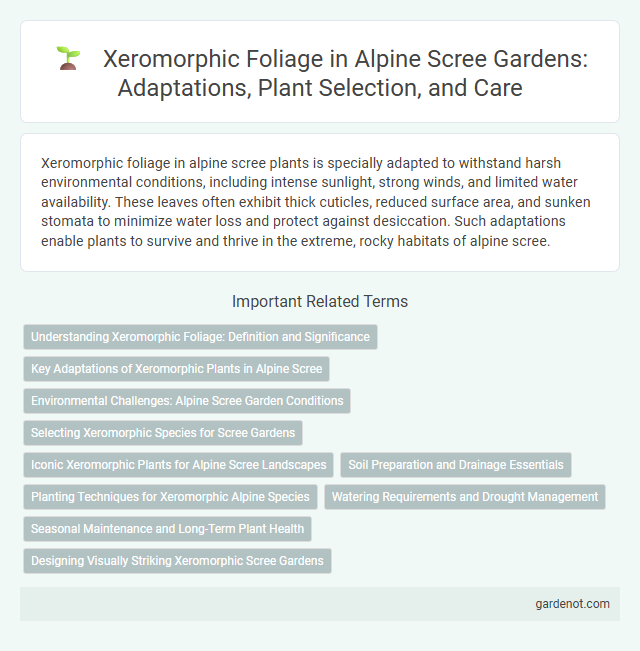Xeromorphic foliage in alpine scree plants is specially adapted to withstand harsh environmental conditions, including intense sunlight, strong winds, and limited water availability. These leaves often exhibit thick cuticles, reduced surface area, and sunken stomata to minimize water loss and protect against desiccation. Such adaptations enable plants to survive and thrive in the extreme, rocky habitats of alpine scree.
Understanding Xeromorphic Foliage: Definition and Significance
Xeromorphic foliage refers to plant leaves adapted to minimize water loss in harsh environments, featuring thick cuticles, reduced stomatal density, and sunken stomata. These structural adaptations are crucial for alpine scree plants, which endure intense sunlight, strong winds, and limited water availability. Understanding xeromorphic traits helps explain plant survival strategies and ecosystem dynamics in alpine scree habitats.
Key Adaptations of Xeromorphic Plants in Alpine Scree
Xeromorphic plants in alpine scree exhibit thick, leathery leaves with a dense cuticle that minimizes water loss while protecting against intense UV radiation and desiccating winds. Their reduced leaf surface area and sunken stomata limit transpiration, ensuring survival in nutrient-poor, well-drained rocky substrates. These adaptations enable efficient water retention and tolerance to extreme temperature fluctuations characteristic of alpine scree environments.
Environmental Challenges: Alpine Scree Garden Conditions
Xeromorphic foliage in alpine scree plants demonstrates adaptations to extreme environmental challenges such as intense solar radiation, low nutrient availability, and drastic temperature fluctuations. These leaves exhibit features like thick cuticles, reduced surface area, and sunken stomata to minimize water loss and enhance drought resistance. The harsh, rocky substrate and rapid drainage in scree gardens intensify the need for such xeromorphic traits, ensuring plant survival under severe alpine conditions.
Selecting Xeromorphic Species for Scree Gardens
Xeromorphic foliage exhibits adaptations such as thick cuticles, sunken stomata, and reduced leaf surface area to minimize water loss, making these species ideal for alpine scree gardens. Selecting xeromorphic species like Sedum, Sempervivum, and Daphne ensures resilience in harsh, well-drained scree conditions with limited moisture retention. These plants thrive on rocky substrates, providing stability and aesthetic appeal while conserving water in challenging alpine environments.
Iconic Xeromorphic Plants for Alpine Scree Landscapes
Iconic xeromorphic plants thriving in alpine scree landscapes include species like Saxifraga oppositifolia, Silene acaulis, and Arenaria montana, which exhibit specialized adaptations such as thickened leaves and reduced stomatal density to minimize water loss. These plants possess dense, often pubescent foliage and deep root systems that enable survival in the harsh, nutrient-poor, and well-drained scree environment. Their xeromorphic traits are critical for conserving moisture and withstanding extreme temperature fluctuations common in alpine scree habitats.
Soil Preparation and Drainage Essentials
Alpine scree environments require xeromorphic foliage adapted to harsh, well-drained soils with minimal moisture retention. Effective soil preparation involves incorporating gritty sand and organic matter to enhance drainage and aeration, minimizing waterlogging risks. Proper drainage systems, such as raised beds or rock-lined trenches, ensure rapid water runoff, supporting the survival of drought-resistant alpine plants.
Planting Techniques for Xeromorphic Alpine Species
Xeromorphic foliage in alpine scree plants displays thick cuticles, sunken stomata, and reduced leaf area to minimize water loss in harsh, rocky environments. Effective planting techniques for xeromorphic alpine species include using well-draining, gritty substrates to mimic natural scree conditions and positioning plants in full sun with adequate air circulation to prevent moisture-related diseases. Incorporating mulch made of small stones or gravel enhances root aeration while reducing evapotranspiration, promoting healthy growth in xeromorphic foliage adaptations.
Watering Requirements and Drought Management
Xeromorphic foliage in alpine scree plants features thickened cuticles and reduced leaf surface area to minimize water loss, making these species highly drought-tolerant. Their watering requirements are minimal, typically relying on natural precipitation and occasional micro-moisture from fog or dew. Effective drought management involves ensuring well-drained soil to prevent root rot while allowing plants to maintain hydration in harsh, low-moisture environments.
Seasonal Maintenance and Long-Term Plant Health
Xeromorphic foliage in alpine scree exhibits specialized adaptations such as thick cuticles and reduced leaf surface area, minimizing water loss during dry, cold seasons. Seasonal maintenance involves careful mulching and selective pruning to remove dead or damaged leaves, preserving the plant's energy for regrowth and enhancing overall resilience. Long-term health depends on maintaining well-drained, nutrient-poor soils that mimic natural alpine conditions, preventing root rot and promoting sustained xeromorphic function.
Designing Visually Striking Xeromorphic Scree Gardens
Xeromorphic foliage in alpine scree gardens exhibits thick, waxy leaves with reduced surface area, adaptations that minimize water loss and enhance drought resistance. Incorporating these plants into garden designs creates visually striking contrasts with their textured, silvery-green hues and sculptural forms, perfectly suited to rocky, well-drained substrates. Strategic placement of species such as Sempervivum, Saxifraga, and Sedum enhances both aesthetic appeal and ecological function in xeromorphic scree landscapes.
Xeromorphic foliage Infographic

 gardenot.com
gardenot.com